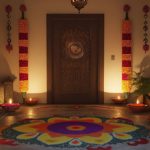
Vastu for East-Facing Homes – Design Secrets to Embrace Sunrise Energy
An east-facing home is often considered auspicious, as it welcomes the rising sun and the positivity it carries. According to Vastu principles, sunlight plays an important role in influencing health, prosperity, and happiness. Following vastu for east-facing homes can help homeowners create a living space that not only looks beautiful but also feels harmonious and full of good energy.
Why east-facing homes hold significance
East is the direction of the rising sun, symbolizing hope, growth, and clarity. Homes that open towards this direction are thought to bring prosperity and good health when designed with proper planning.
- Early morning sunlight brings natural warmth and freshness.
- Spaces receive abundant daylight, reducing dependence on artificial lighting.
- It is believed to strengthen positive energy flow in the household.
This makes east-facing homes highly preferred among those who value both tradition and functionality.
Placement of main entrance and rooms
The location of the entrance plays a crucial role in Vastu, especially for east-facing properties.
- The main entrance should ideally be towards the northeast corner to maximize benefits.
- Living rooms near the entrance are considered ideal for welcoming positivity.
- Bedrooms are recommended in the southwest to ensure rest and stability.
- Kitchens placed in the southeast are in alignment with the element of fire.
A thoughtful layout helps maintain balance and ensures each room aligns with its intended purpose.
The role of sunlight in energy balance
Following vastu for east-facing homes ensures that the maximum use of sunlight is achieved. Proper utilization of this natural element helps keep the environment cheerful and healthy.
- Large windows on the eastern side allow abundant light during mornings.
- Ventilation in the east ensures airflow remains fresh and uplifting.
- Avoiding tall obstructions in front of the home ensures sunlight enters freely.
These simple adjustments enhance comfort while also improving the overall energy of the house.
Practical design features that support Vastu
Even in modern architecture, small changes can make a big difference when aligned with Vastu.
- Staircases should preferably be built in the south, west, or southwest.
- Pooja rooms or meditation spaces are best suited for the northeast corner.
- Bathrooms should be in the northwest or west direction for balance.
- Avoid keeping heavy storage in the northeast as it may block positive energy.
Such design practices not only improve Vastu alignment but also enhance practicality in daily living.
Blending modern aesthetics with tradition
Today’s homes require more than just traditional layouts—they need to reflect modern lifestyles as well. Blending both ensures a space that is both functional and peaceful.
- Compact apartments can still follow Vastu through correct orientation of furniture.
- Remedies like mirrors, lighting, or indoor plants can balance areas where structural changes aren’t possible.
- Decorative elements such as earthy tones or natural materials can align with Vastu while adding elegance.
This thoughtful mix ensures that homes remain stylish while staying connected with positive energy principles.
The importance of guided planning
Designing a home requires balancing personal needs, design preferences, and traditional guidelines. For homeowners, following a vastu for east-facing homes layout ensures that spaces are harmonious and uplifting. With the help of experts, planning becomes easier, as they can adapt Vastu principles to suit modern homes without compromising aesthetics.
In today’s world, many families turn to a reliable home interior decor company in Mumbai to help merge tradition with modern design. By doing so, they create homes that reflect beauty, functionality, and a sense of positive flow. A well-planned east-facing home is not only a place to live but also a space that encourages growth and well-being, making it a thoughtful choice for those who value both design and harmony.






